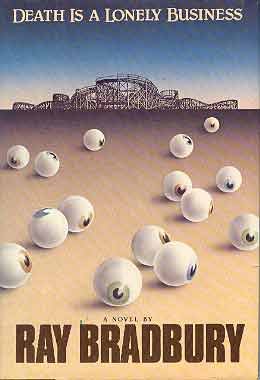Describing Ladies, a la Bradbury

First Edition Cover
It’s no secret I love the stories of Ray Bradbury. I haven’t read everything he’s written and now that he’s passed, I’m glad for that, because it means if I pace myself, I have a lot more Bradbury fiction to come.
I’m in the middle of Death is a Lonely Business at present and it keeps knocking my socks off. I’m taking my time with it, because I don’t want it to end. Venice, California, a drowned circus, a demolished boardwalk, a lady who once sold canaries, the strange garden of an even stranger policeman, and a young author who is determined to make something of himself. It’s like crack. Instructive crack. I find Bradbury technique sinking into my bones at every turn. This time, we’re going to peek at a few descriptions of ladies! (Of course.)
It’s easy to tell your reader that your heroine is 5’5″ tall, that she was bombshell beautiful, and men adored her 22″ waist! But what does that actually tell us about the character herself? Not much. My height is really only relative when I’m trying to reach something on a high shelf—maybe if that’s a plot point in your story, height is important. Otherwise, why confine your characters to a list of numerical facts? What does someone’s bust size have to do with the story you are telling? How does Bradbury introduce his female characters?
She had been all summer in Mexico, finishing studies in Spanish literature, learning the language, traveling on trains with mean peons or buses with happy pigs, writing me love-scorched letters from Tamazunchale or bored ones from Acapulco where the sun was too bright and the gigolos not bright enough; not for her anyway, friend to Henry James and consultant to Voltaire and Benjamin Franklin. She carried a lunch bucket full of books everywhere. I often thought she ate the brothers Goncourt like high tea sandwiches in the late afternoons.
Peg.
We are introduced to Peg, Our Hero’s ladylove in Death is a Lonely Business. Do you have to be told what she looks like after reading those paragraphs? I have a picture of Peg in my head and I wager you do, too. She’s possibly suntanned from spending time in the Mexico sunshine; I’d bet her hair was a bit disorganized, no matter its length. Glasses maybe, because she reads so much, peering over the edge of them to eye those gigolos with disdain. Peg.
Even when Bradbury works in physical description, it’s never paint by the numbers. Here, Guy encounters Clarisse in Fahrenheit 451:
The autumn leaves blew over the moonlit pavement in such a way as to make the girl who was moving there seem fixed to a sliding walk, letting the motion of the wind and the leaves carry her forward. Her head was half bent to watch her shoes stir the circling leaves. Her face was slender and milk-white, and in it was a kind of gentle hunger that touched over everything with a tireless curiosity. It was a look, almost, of pale surprise; the dark eyes were so fixed as to the world that no move escaped them.
Bradbury shows us how she moves through Guy’s eyes—later tells us that her white dress whispers, that “he thought he hard the motion of her hands as she walked, and the infinitely small sound now, the white stir of her face turning when she discovered she was a moment away from a man who stood in the middle of the pavement waiting.”
We don’t need to know how tall she is—read again how she moves, picture those observant eyes. It’s so simple. It’s so perfect for what’s to come.
In closing, a little Something Wicked This Way Comes:
Why love the woman who is your wife? Her nose breathes in the air of a world that I know; therefore I love that nose. Her ears hear music I might sing half the night through; therefore I love her ears. Her eyes delight in seasons of the land; and so I love those eyes. Her tongue knows quince, peach, chokeberry, mint and lime; I love to hear it speaking. Because her flesh knows heat, cold, affliction, I know fire, snow, and pain. Shared and once again shared experience.
When you next describe a female character, go deeper.

Death is a Lonely Business and Graveyard for Lunatics, were my first real loves among Bradbury’s writing. Even though it was written much later, Let’s All Kill Constance falls right back into the world of the first two books. I think I’m about due for another re-read of all three…
On an unrelated note, I love your Captcha, but I always want to disobey instructions and make the most ridiculous combination possible. Who doesn’t take sheep with their coffee?
I always take sheep with mine!
And I was pretty excited to learn there were more books in this universe. Woo!